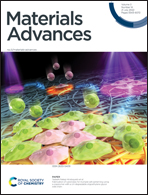Activated carbon derived from glutinous rice via gamma radiolysis for lithium–sulfur battery cathodes
Abstract
Although lithium-sulfur batteries (LSBs) have high theoretical capacities (1675 mA h g−1), an irreversible charge/discharge process (shuttle effect) due to polysulfide and insulating lithium sulfide (Li2S) formation causes the death of battery cells. This study aims to solve the shuttle effect by anchoring polysulfide onto porous carbon/sulfur cathodes via chemical interactions. The porous activated carbons were derived from glutinous rice (RAC) and were modified through water (RAC-W) or ammonia radiolysis (RAC-N) using a gamma source (25 kGy). The specific capacities of LSBs obtained from RAC-W and RAC-N are >900 mA h g−1 and they are stable for more than 150 cycles, which is significantly higher than that of unmodified RAC. Furthermore, carbonyl and pyridinic nitrogen moieties formed in RAC-W and RAC-N from gamma radiolysis result in enhanced interactions between polysulfide and the cathode framework.



 Please wait while we load your content...
Please wait while we load your content...